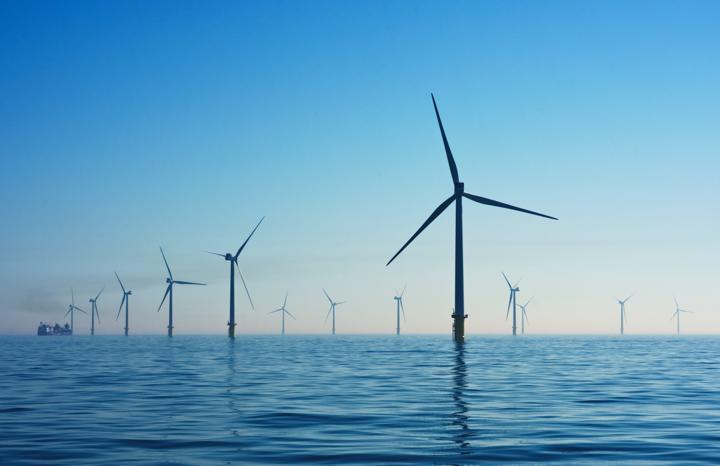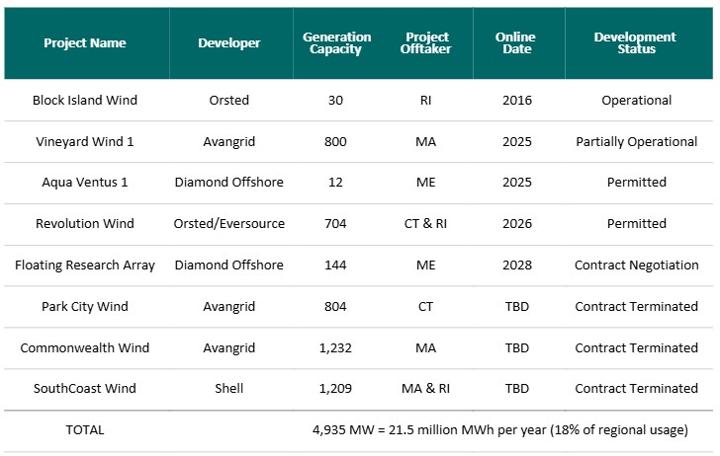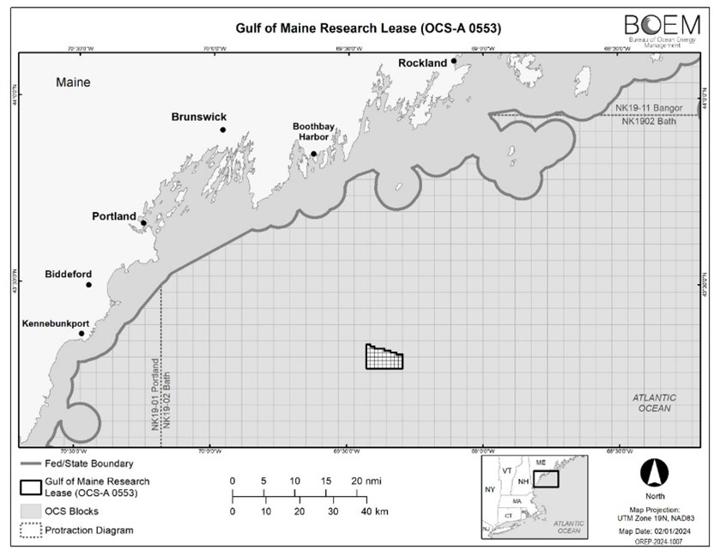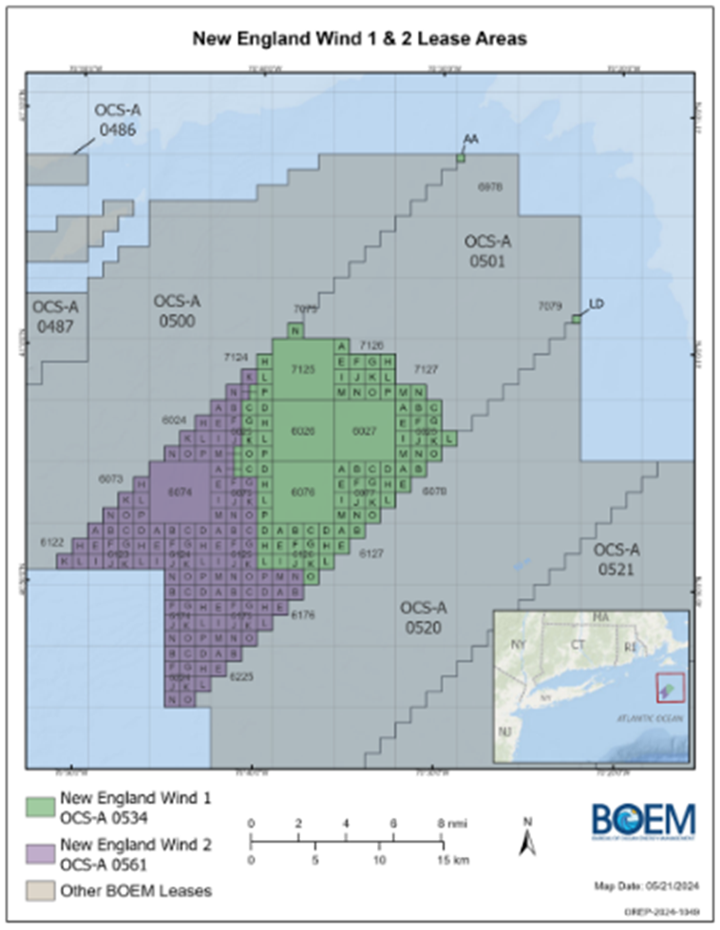
By Charlotte Del Col, Associate Manager of Analytics
Offshore wind energy is a complex and often polarizing technology, but it also has incredible potential to meet renewable energy goals and has become a critical part of many renewable energy roadmaps and state renewable portfolio standards (RPS).[1] China currently has the largest number of online offshore wind turbines by country, with more than a quarter of total global capacity. China also has plans to add an average of 2.8 gigawatts (“GW”) of offshore wind power annually for the next three years. While other countries like the U.K. and Germany have also rapidly expanded offshore wind adoption, the U.S. has historically lagged in implementing this technology due to numerous stakeholder conflicts, and lack of designated development areas. Despite the country’s slow start, the Biden administration has established a target to develop 30 GW of offshore wind by 2030. Below you will see a list of proposed projects in the New England region along with their status. With aggressive renewable goals, many New England states have pledged large subscriptions to offshore wind projects. Below you will see a timeline of currently proposed New England offshore wind projects along with their sizes. Project Name Developer

After decades of planning, leasing and construction processes, some projects are finally beginning to come online to deliver power to New England off takers. While some projects are taking off, there has also been a trend of project terminations as well. In the last few months, a handful of projects have been cancelled due to supply chain disruptions, regulatory hurdles and increasing costs. In this month’s blog post, I will look to give the broader CES community a general sense of the status of where offshore wind stands across the New England States.
Maine (ME)
The state of Maine has served as a pioneer in offshore wind development. Maine has enacted LD1895 which pledged an offshore wind procurement goal of 3,000 MW, which they plan to achieve by 2040. Maine is also the first state to begin pursuing a floating offshore wind array, which would be the first of its kind in the United States. On May 24, 2024, the Bureau of Ocean Energy Management (BOEM) offered a lease of land to the state of Maine, which will allow Maine to initiate a Power Purchase Agreement and coordinate applications with the Maine Public Utilities Commission for a floating offshore wind farm. This process will likely take a minimum of four years and is an exciting first step in the underexplored technology of floating wind. The image below depicts the general area where the proposed floating wind project would be:

In February 2023 the state of Maine released their Maine Offshore Wind Roadmap which seeks to outline the state’s objectives around offshore wind, with respect to five key topics: “Supporting economic growth and resiliency, harnessing renewable energy, advancing Maine-based innovation, supporting Maine’s seafood industry, and protecting the Gulf of Maine ecosystem.” These key topics will remain paramount in the coming decades and will serve as a strong baseline for all New England states attempting to navigate the offshore wind transition.
Massachusetts (MA)
MA was the first state to pass dedicated offshore wind legislation, and in 2022 MA passed an Act Driving Clean Energy and Offshore Wind (H 5060), which included provisions to expand offshore wind. The United States’ first large scale commercial offshore wind project, Vineyard Wind is currently under construction off the coast of Massachusetts, with 10 of the 62 total turbines already online. For perspective, these 10 turbines generate 136 MW of power, and can power 60,000 homes in MA. As of June 2023, Massachusetts had procured more than 3,200 MW of offshore wind capacity from PPAs. However, due to unforeseen cancelations and terminations, MA ended 2023 with less than 1,000 MW of capacity procured. MA is currently waiting for responses from a joint RFP with RI and CT for up to 6,000 MW which I will discuss in more detail later in this blog post.
Connecticut (CT)
In 2022, Connecticut Governor Ned Lamont signed into law Public Act 22-5: An Act Concerning Climate Change Mitigation, in which the state committed to a 100% zero-carbon electricity supply by 2040. CT has ambitious offshore wind goals as part of achieving zero-carbon electricity: in 2019 the state authorized the procurement of up to 2,000 MW of offshore wind energy by 2030. While this volume is smaller than the pledges made by ME and MA, it is equivalent to close to 30% of CT’s total electricity consumption, which was the largest authorization commitment by load percentage at the time of declaration. Connecticut has since launched the Connecticut Wind Collaborative, and they have also collaborated with New York, Rhode Island, as well as offshore wind developer Orsted and CT utility Eversource on three offshore wind projects, which kicked off in 2023.
New Hampshire (NH)
At this moment New Hampshire has not committed to any offshore wind procurement volumes like their New England counterparts. However, they are a part of BOEM’s Gulf of Maine Intergovernmental Renewable Energy Task Force on offshore wind with MA and ME. New Hampshire’s participation is increasingly important due to their existing port facilities in Portsmouth, which is strategically positioned near the center of New England and could aid in manufacturing and installing turbines.
Vermont (VT)
Although Vermont does not have any coastline, they still intend to participate in offshore wind procurement in collaboration with other New England States. On June 17, 2024, both Vermont’s house and senate passed H.290, overriding a Governor veto, which updates the State’s RPS, mandating that Vermont utilities to reach 100% renewable electricity by 2035. In Vermont’s 2022 Comprehensive Energy Plan, a 300-page document laying out potential scenarios and goals for the state to achieve before 2050, the state lays out multiple mitigation scenarios, with offshore wind comprising a variable but consistently substantial portion of Vermont’s proposed energy mix.
Rhode Island (RI)
Rhode Island may be small, but they are mighty, and in many ways have led the charge for offshore wind, not just in New England but for the entirety of the U.S. The nation’s first commercial offshore wind farm, the Block Island Wind Farm, is a 30 MW project in the state waters around Block Island, RI that came online in 2016. Further, Rhode Island has committed to 100% clean electricity by 2033 through its very aggressive RPS. In an effort to help meet this RPS, RI contracted developers for a proposed wind project called the Revolution Wind Project, which would have created around 1 GW of offshore wind capacity. The project was ultimately cancelled due to high costs for customers which were caused by increased capital costs, high interest rates and supply chain expenses.
Opportunity for Interstate Collaboration
At this point, all New England States have separately set limits or goals to reduce their 2050 GHG emissions by 80% or more relative to 1990 emissions levels. Each state has released their own Bill pertaining to climate change which set these goals that are expected to require ~30-45 GW of offshore wind capacity for the region, according to New England for Offshore Wind. Given the potential scale of this resource, offshore wind has posed an opportunity for interstate collaboration. One of the most recent examples of this collaboration has come in the form of the New England Wind 1 and 2 projects, which would occupy the ocean space just southwest of the existing Vineyard Wind project.

The project received final approval for their construction and operations plan for the two projects from BOEM on July 1, 2024. This project would consist of up to 129 turbines and have a total capacity of up to 2,600 MW which could generate enough power for more than 900,000 homes. This lease agreement is a collaborative effort across MA, CT and RI, and was announced in October of 2023. While the RFP is related to the parcels above, its solicitation was looking for projects relevant to the planning, deployment and operations of offshore wind in southern New England and the Gulf of Maine, as well as a request for applied research around offshore wind. Thus far the project has received bids from Ørsted, Avangrid, SouthCoast Wind, and Vineyard Offshore, but awards will not be made until later in the summer.
While this list of recent developments is certainly not comprehensive, I hope it gives a brief snapshot of the current status of offshore wind in New England. Returning to my sentiment from the beginning of the blog post, offshore wind is complex, and projects can often take many years if not decades to complete. The regulation process is time intensive, and often requires many conflicting stakeholders to agree. However, with multi-state collaboration, inclusivity of stakeholders, comprehensive policy, and a thoughtful approach, projects will continue to be implemented to assist states with reaching their renewable goals.
Photo by Nicholas Dougherty
Sources:
https://www.newenglandforoffshorewind.org/states/overview/
https://cleanpower.org/facts/offshore-wind/
https://www.maineoffshorewind.org/
https://www.mass.gov/info-details/offshore-wind
https://www.cleanenergynh.org/offshore-wind
[1] For more on Renewable Portfolio Standards, see our previous blog post: https://www.competitive-energy.com/blog/renewable-portfolio-standard
